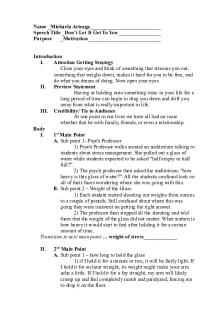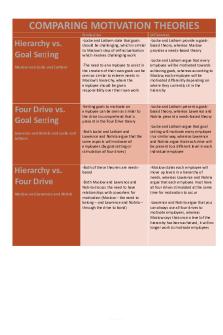MOTIVATIONAL INTERVIEWING PDF

| Title | MOTIVATIONAL INTERVIEWING |
|---|---|
| Author | Baileigh Skinner |
| Course | Psychological Interventions |
| Institution | La Trobe University |
| Pages | 4 |
| File Size | 91.6 KB |
| File Type | |
| Total Downloads | 49 |
| Total Views | 150 |
Summary
Contains notes about Motivational Interviewing...
Description
PSYPIN3: WEEK 12- MOTIVATIONAL INTERVIEWING -
Counselling approach Developed by William R Miller and Stephen Rollnick Client-centred Elicitin behaviour change by helping clients to explore and resolve ambivalence Ambivalence = the contemplation stage Pre contemplation= change not being considered Aim is action stage Balance of change talk: verbalizations favouring change/ Sustain talk: favouring the status quo The ratio of change talk to sustain talk during treatment sessions predicts likelihood of subsequent behaviour change Relative pros to cons increase If Therapists evoke more sustain talk or “resistance” than change talk, clients are less likely to change DECISIONAL BALANCE: involves actively evoking and exploring all the pros and cons of change, thus causing clients to voice both change and sustain talk Doing this with ambivalent people DECREASE their commitment to change
WHAT IS MI? - Conversation about change - Client rather than clinician voicing change - Rooted in person-centred approach of carl rogers FOUR PROCESSES OF MI: EFEP 1. Engaging: developing a therapeutic alliance that facilitates working together 2. Focusing: clarifying the goals and direction of counselling. Clear goal in place, the 3. EVOKING process involving eliciting the client’s own motivation for change. Attending to the clients change talk, seeking to evoke, understand, reflect, explore, and summarise it. 4. Planning: when there is clear readiness for change. Processes are recursive One may double back from planning to evoking if motivation seems to wane UNDERLYING SPIRIT OF MI: - Empathy is central to the first of four fundamentals of the spirit of MI - Acceptance honouring client’s autonomy, affirming their strengths, and respecting each person’s absolute worth as a human being - Partnership a collaboration between the clinician’s expertise and clients own expertise about themselves. - Compassion is the intention to give primacy to the client’s own welfare, growth, and best interests - Evocation is the mindset of calling forth the client’s own wisdom, values, ideas, and plans.
-
Opposite of deficit model- that the client is lacking something that the therapist needs to install. Underlying message of MI is “you have what you need, and together we will find it”
Being combined with CBT MI has the most enduring effects when it is combined with another active treatment MET- good for pre-contemplation level
BASIC ENGAGING SKILLS OF MI - Four micro skills used throughout MI, OARS 1. O- Open questions that give client’s latitude in how to respond. Persons own expertise about themselves. Avoids clinician being expert. 2. A- Affirming. Clinicians watch for and affirm clients’ strengths and abilities. Each step no matter how small is recognised and affirmed. Clients asked to describe their own strengths, “self-affirmation” = strengthens therapeutic alliance and reduce defensiveness. Catch people doing something right. “It took courage to do that” and “that’s a really good idea” 3. R- Reflection (most used), a key method for experiencing and communicating accurate empathy. Continuing the paragraph, not repeating what the client has just said, instead saying what might be next. Empathetic reflection. What the client if feeling and the reasoning for that feeling. Reflects the emotion of what is said 4. S- Summarize, a reminder the summarize. Show that you have been listening and value what clients say enough to remember it; link material together and can help emphasize points. -
-
Offer advice and info when appropriate. And only with PERMISSION and not tell clients what they already know. “would it be helpful if I told you some things that other people have done that worked for them?” “you may or may not agree” provides autonomy Elicit-provide-elicit
FOCUSING: - Focus for conversations about change is set by the context - Identify mutually acceptable goals EVOKING: - Most unique to MI - Exploring the clients’ own motivations to change - Recognizing, eliciting, and responding to change talk - Does not disrespect or ignore sustain talk Recognising change talk: - Anything clients say that signals a move toward or openness to change - DARN: desire, ability, reasons, and need - Preparatory, signal inclination toward change without committing to it
-
Mobilizing change talk= CATS (Commitment, Activation, and Taking steps) They signal movement in the direction of change
PSY3 PIN LECTURE: - Benefits of change and costs of staying the same - Benefits of staying the same and the costs of change - Weigh the pros and cons - Clients are ambivalent about change - Behaviour change is hard - Individualised set of reasons for not changing/ wanting to change - Only help if we UNDERSTAND THESE REASONS - Clients have the CAPACITY TO CHANGE - MI works by ASSISTING people tap into these capacities - Person centred - Goal directive (critical) - Normal centred is not goal directed - Resolving ambivalence - Eliciting (drawing out) and strengthening people motivation - Promoting positive change - Collaborative conversation - Case for change comes from the client - Traditional behaviour change therapy = telling people what to do - CHANGE TALK: consistent with change -
Get a sense of where people are right now
-
MI is a partnership: gently guiding someone
-
Engage: develop a working relationship
-
ROARS (refrain, open, affirm, reflect, summarize)
-
Open ended questions, non-directive. Encourages clients to come up with their own ideas. “Could you go with a friend” = directive. Let them create their own ideas.
-
Reflections are a curious guess, rather than an interpretation. Rephrase what client said.
-
More complex reflections: listening in action. Understand them and facilitate behaviour change. Reflections don’t have to be perfect. Try and understand your client
-
Promote change talk (why are you a 5 rather than a 1?) – confidence and importance
-
Use affirmations (positive true statements about someone)
-
Focus: focus in on what the client wants/ is willing to change
-
Evoke: evoke persons own motivation for behaviour change
-
Plan: develop goals collaboratively, plan to achieve them
Options for working with resistant clients: - Push harder= outcome? - Person will push back harder, more sustain talk. Does not work to push them - Explore resistance with client. Be curious - Reframe resistance as positive- facilitator of change POWER OF REFLECTIVE LISTENING: video -
-
Let’s him drive the conversation, and share all his feelings and thoughts about smoking. Encourages him. Expresses interest in his story. Reinforces what he just said, offers reflection Shows she understands what he is saying Asks limited questions Affirms his thoughts Opens the conversations Reflects on what he’s expressed, and confirms his thoughts and feelings Starts saying he’d smoke right now. Weigh’s pros and cons of smoking. Then realises its harder to smoke than it used to be
Johns’ benefits of change: - Feeling good about himself - Able to create a steady income again Cost of change:
MI TUTORIAL: -...
Similar Free PDFs

MOTIVATIONAL INTERVIEWING
- 4 Pages

Motivational Interviewing
- 13 Pages

Motivational interviewing relias
- 5 Pages

Interviewing
- 19 Pages

Motivational Modelling Handout
- 14 Pages

Outline motivational speech
- 3 Pages

Three Motivational Theories
- 5 Pages

Interviewing and investigation
- 13 Pages

COM 335A Motivational Appeals
- 1 Pages

Interviewing a Student Scientist
- 1 Pages

Comparing Motivational Theories
- 1 Pages

Interviewing Francis Bacon
- 9 Pages
Popular Institutions
- Tinajero National High School - Annex
- Politeknik Caltex Riau
- Yokohama City University
- SGT University
- University of Al-Qadisiyah
- Divine Word College of Vigan
- Techniek College Rotterdam
- Universidade de Santiago
- Universiti Teknologi MARA Cawangan Johor Kampus Pasir Gudang
- Poltekkes Kemenkes Yogyakarta
- Baguio City National High School
- Colegio san marcos
- preparatoria uno
- Centro de Bachillerato Tecnológico Industrial y de Servicios No. 107
- Dalian Maritime University
- Quang Trung Secondary School
- Colegio Tecnológico en Informática
- Corporación Regional de Educación Superior
- Grupo CEDVA
- Dar Al Uloom University
- Centro de Estudios Preuniversitarios de la Universidad Nacional de Ingeniería
- 上智大学
- Aakash International School, Nuna Majara
- San Felipe Neri Catholic School
- Kang Chiao International School - New Taipei City
- Misamis Occidental National High School
- Institución Educativa Escuela Normal Juan Ladrilleros
- Kolehiyo ng Pantukan
- Batanes State College
- Instituto Continental
- Sekolah Menengah Kejuruan Kesehatan Kaltara (Tarakan)
- Colegio de La Inmaculada Concepcion - Cebu



